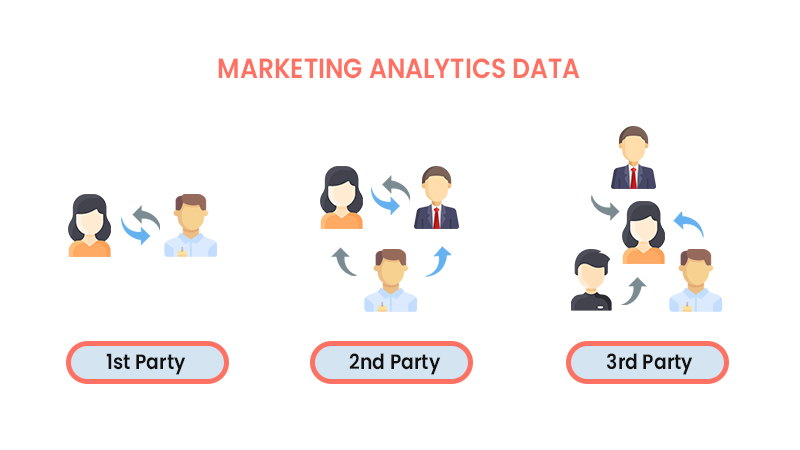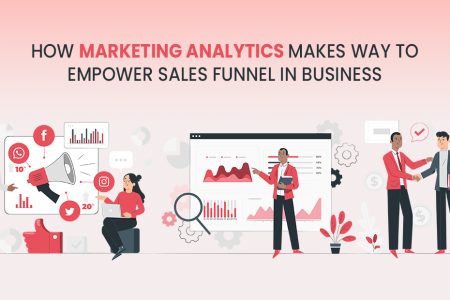Marketing analytics is the method of organizing and analyzing metrics data to determine the return on investment (ROI) of marketing efforts and identify areas for improvement. The development of marketing analytics was accelerated by the advent of the internet. Digital attribution models were first used by marketers to analyze consumer behavior at a more detailed level.
These models assess each consumer’s touch point’s relevance in order to determine the circumstances behind a person’s most successful brand encounters. Multi-touch attribution soon followed, giving marketers the ability to monitor a consumer’s journey across numerous devices and channels. Depending on the KPIs being monitored, many approaches and models can be used to analyze marketing data.
Marketing Analytics: Converting Interest Into Insight

In order to shed light on issues and provide answers, analytics makes use of statistics, predictive modeling, and machine learning. Analytics are used to determine things like weather forecasts, baseball batting averages, and life insurance plans. Analytics are essential in the realm of digital marketing for comprehending the effects of marketing, forecasting marketing trends, user behavior, and improving the user experience (UX) to increase sales.
You can track campaigns and their associated results using marketing analytics, particularly Internet (or Web) marketing analytics, allowing you to make the most of every dollar spent. Marketing analytics are essential since it is never a good long-term business plan to spend more money than you make.
Keywords are one of the most potent marketing performance measurements, especially in search marketing. You can find out exactly what your present and potential clients are thinking by using keywords. In essence, the most beneficial long-term outcome of using paid and organic search marketing isn’t more visitors to your website; rather, it’s the keyword information that each click contains, which can be used to guide and improve other business procedures.
Also Read: Marketing Attribution: A Marketer’s Roadmap To Better Understand A Customer’s Buying Journey
Sourcing Data For Marketing Analytics

You must first gather, combine, and organize the data you will use to monitor target progress, obtain customer insights, and inform strategic decisions. Customer data comes in three varieties: first-party, second-party, and third-party.
- Your company gathers first-party data directly from your users. Due to the fact that you learn about the attitudes, behaviors, and feelings of your audience, it is regarded as the most valuable data category.
- Second-party data is information about a company’s clients that is shared with another organization (or its first-party data). If your target audiences are the same or share a similar demographic, your companies are having a joint promotion, or you have a partnership, it might be helpful.
- Data that has been gathered and rented out or sold by companies that are not affiliated with your business or users is referred to as third-party data. Third-party data isn’t the most trustworthy because it doesn’t originate from your consumers or a solid second-party source, despite the fact that it is acquired in enormous volumes and can offer details about users similar to yours.
Although it’s crucial to be aware of the existence of second and third party sources, first party data is the most trustworthy of the three as it comes from your consumers themselves and reflects their attitudes, beliefs, and behaviors.
Data on marketing must be gathered and formatted before analysis due to the variety of data kinds and sources. Several of these platforms allow you to collect and gather data as well as do studies and employ algorithms to extract critical insights. Data can also be manually analyzed by exporting datasets into statistical software like Microsoft Excel or another application, visualizing the data using graph or chart tools, and performing regressions and other analytical tests.
Impact on Marketing Journey
No matter how big or small your firm is, you probably know what your sales funnel looks like. This process lasts from the point at which they first become leads through their (often protracted) decision-making process and ends with the actual sale. A sale typically doesn’t indicate that the customer has left your funnel. Consumers are often in your funnel once they make a purchase because there is always a probability that they will return as repeat customers.
Awareness
The awareness stage is where you entice and educate people at the “head of the funnel.” Wherever your target audience is most active online is where your campaigns, adverts, and content will appear. The major objective at this point is to establish brand and/or product recognition.
The main objectives of awareness campaigns are to expand your organic audience and keep them interested. Here, marketing measures like reach, frequency, and engagement are important. In most cases, it is impossible to precisely predict how these early efforts would affect society in the future. Companies who invest in brand promotion do understand its long-term value, though.
Consideration/Conversion
At these later stages, customers are actively evaluating their product selections and acting on them. To encourage conversion, you must persuade them at this point. A clear call to action and an easy mechanism to complete the transaction should be included in the message.
These customers might discover you via organic or paid search, recommendations, affiliates, or influencers. Sales, sign-ups, and other action objectives are examples of marketing KPIs. After the sale is completed, check your marketing analytics dashboard to start calculating the conversion rates of your marketing campaigns.
Retention
Marketers need to maintain the relationship with customers after conversion in order to keep their brands in the forefront of their customers’ minds. At this point, an email list is a valuable resource. Campaigns for retention that are tailored to each customer can greatly benefit from email marketing metrics like click-through rates.
To keep a strong customer profile, all consumer marketing data sources are essential. The data will guide ongoing strategies like retargeting, social media advertising, and search engine marketing.
Marketing Analytics Business Utilities
Companies can incorporate marketing analytics into their current applications in a variety of ways, from targeted uses to more comprehensive management suites. Businesses’ needs will also vary depending on the marketing platforms they employ. For example, the majority of businesses who utilize social media advertising on Facebook, Twitter, and Instagram use data to determine the most effective approach and identify opportunities to raise engagement.
Multichannel strategies enable businesses to more easily track their efforts on a single page, speeding up the analysis and insight process. To build a more complete image of their customers and enhance their ability to connect with them, businesses frequently link their customer relationship management (CRM) software to marketing analytics tools.
Additionally, marketing analytics are helpful for analyzing a marketing and sales funnel because they can highlight the most effective sections and identify any bottlenecks. To monitor success measures like ROI, clickthrough, cost per lead, and lead-to-customer ratio, marketing analytics are frequently used. This aids businesses in developing conversion-focused strategies and improving their ability to foresee shifting customer preference patterns.
-
Quantified Metrics For Impact
You can only think broadly without precise marketing data points, such as your ROI before and after a campaign. While a specific ad was running, either your income increased or it didn’t. Analytics enables you to use the data from that time period to calculate the marketing impact of a specific campaign, or how much money it actually brought in.
Obtaining finance is significantly simpler if you can determine whether the marketing effort itself was successful. Additionally, you can avoid spending money on pursuing the endeavor if it doesn’t succeed. With the use of marketing analytics, you can distinctly show not just whether or not something is effective, but also why. And using that “why,” you can persuade people to modify their behavior.
-
Predictive analytics
Real-time analytics are crucial, but they no longer suffice to explain what has happened in the past or even what is happening right now. Making future projections is essential for implementing the most effective marketing tactics.
You can see into the future with the help of predictive analytics. To assess the outcomes you should anticipate under certain circumstances, these tools make use of specific data and historical trends. These observations ultimately serve as the deciding factor for corporations and aid in investment decisions.
-
Campaign optimization
Only when marketers use their raw data to evaluate current performance, spot areas for development, and apply these learnings to future campaign performance optimization do they generate value from it.
A/B testing, for instance, is a crucial component of marketing analytics that enables marketers to quickly evaluate various strategies, such as running two ads with drastically different designs and copy for the same campaign. Even better, all aspects of marketing, including messaging, visual components, remarketing tactics, and more, can be A/B tested.
A/B testing requires you to become familiar with the entire process of developing a hypothesis, defining the test parameters, such as channels, KPIs, and duration, carrying it out, and relaying these insights into your later analysis.
-
Efficient Segmentation of Consumer Base
You can put comparable prospects together using segmentation and profiling based on the criteria you think are most significant. You can use them to create tailored strategies that appeal to the tastes of each specific category.
In general, possibilities are very diverse. You can’t just use a one-size-fits-all marketing approach because they all have different backgrounds, preferences, and demographic profiles. You can keep reviewing the information from your campaigns and adjusting your client profiles accordingly.
-
Attribution modeling for CPA
The journey your customers followed before making a purchase is revealed by customer journey mapping, but it doesn’t indicate which of these actions was the most crucial. Attribution modeling can help with it. It lists the touchpoints that were involved in a customer’s journey and gives each one a level of credit based on how important it was. Marketers can then focus their resources on initiatives that have shown to be effective.
Now that you have all this data, you need to calculate how much it costs your business to acquire each customer. Fortunately, this can be done by simply dividing the cost of a campaign by the quantity of new clients it brought in.
A program for marketing analytics will monitor the effectiveness of all your cross-channel initiatives, making it simple for you to determine which tactics, goods, and demographics have the lowest cost per acquisition (CPA). To improve your marketing ROI moving forward, invest more extensively in these areas.
Conclusively
Marketing Analytics should be the pillars of your marketing strategy. Your strategy can be customized to the needs of your organization by taking into account which marketing efforts are aiding your lead generation, conversion, and retention. Having clear metrics not only ensures quantified results but also predicts the future of an organization.
